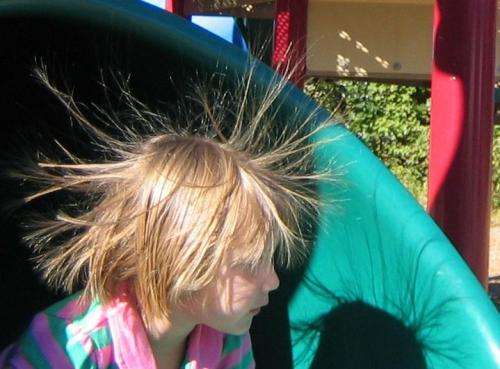September 20, 2013 report
Researchers find antioxidants can dispel static electricity

(Phys.org) —A team of researchers at Northwestern University has found that applying antioxidants such as vitamin E to polymers can cause static charge buildup to disperse without an associated shock. In their paper published in the journal Science, the researchers describe their study of static electricity and how they found a previously unknown relationship between charges and free radicals.
Despite centuries of observation and work, scientists don't really understand how static electricity works, which is a problem because our evolution has led us to a heavy reliance on electronic devices—one tiny spark can render them useless. Sparks can also set off explosions when they occur around gasses and flammable liquids, thus, research continues to find a way to stop static electricity from building up, or from being released in destructive sparks. In this new effort, the research team from Northwestern appears to have found a way to allow polymers to discharge harmlessly using nothing but antioxidant coatings.
Scientists don't really understand how it is that friction causes static electricity to build up, but one thing is clear, most have been overlooking the relationship between charge buildup and free radicals that also exist on a surface. To learn more, the researchers caused static to build up on several types of polymers then took a closer look using atomic force microscopy (a type of microscopy that can map the location of molecules). In so doing, they noticed that static charge builds up in clumps, and it's the clumps that eventually provide a channel for the release of the charge. More importantly, they also noticed that the clumps also had free radicals mixed in with them—a phenomenon that made the researchers wonder if simply applying an antioxidant might cause the release of both the free radicals and the charge in a slow safe manner.
To find out they created several batches of coatings with vitamin E and other antioxidants as a base and applied them to several types of polymers then applied a charge in two different ways: directly through contact with another material, or indirectly using an electrostatic charge. They found the coatings they developed worked to dispel static electricity buildup no matter how it got there—and were able to witness their success as the polymers no longer allowed dust to collect on their surfaces.
The research team has applied for a patent on their coatings, but if their findings can be replicated by other scientists, it will mean the end of run-around solutions to static buildup and the damage that it can cause.
More information: Control of Surface Charges by Radicals as a Principle of Antistatic Polymers Protecting Electronic Circuitry, Science 20 September 2013: Vol. 341 no. 6152 pp. 1368-1371 DOI: 10.1126/science.1241326
Abstract
Even minute quantities of electric charge accumulating on polymer surfaces can cause shocks, explosions, and multibillion-dollar losses to electronic circuitry. This paper demonstrates that to remove static electricity, it is not at all necessary to "target" the charges themselves. Instead, the way to discharge a polymer is to remove radicals from its surface. These radicals colocalize with and stabilize the charges; when they are scavenged, the surfaces discharge rapidly. This radical-charge interplay allows for controlling static electricity by doping common polymers with small amounts of radical-scavenging molecules, including the familiar vitamin E. The effectiveness of this approach is demonstrated by rendering common polymers dust-mitigating and also by using them as coatings that prevent the failure of electronic circuitry.
Journal information: Science
© 2013 Phys.org










.jpg)









